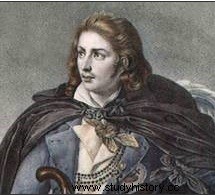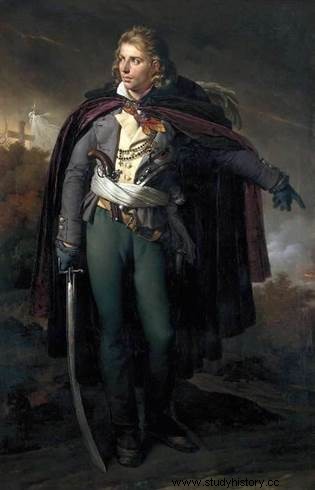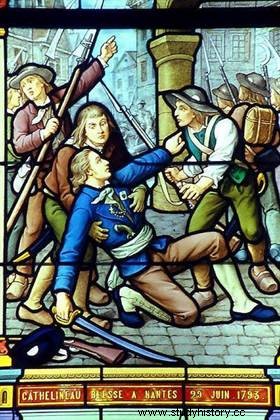 Jacques Cathelineau (1759 - 1793) was a leader of the Vendée insurrection during the French Revolution, nicknamed "the saint of Anjou". Sacristan of his commune, he placed himself at the head of the revolt triggered by the vote, on February 24, 1793, of a levy of 300,000 men to fight the enemies of the Revolution. Having become one of the leaders of the Vendée insurrection alongside the Count of La Rochejaquelein, the Marquis de Bonchamps and General d'Elbée, he was appointed Generalissimo of the "Catholic and Royal Army" by his peers in June 1793. He died the following month (July 14), as a result of the injury he received during the attack on Nantes.
Jacques Cathelineau (1759 - 1793) was a leader of the Vendée insurrection during the French Revolution, nicknamed "the saint of Anjou". Sacristan of his commune, he placed himself at the head of the revolt triggered by the vote, on February 24, 1793, of a levy of 300,000 men to fight the enemies of the Revolution. Having become one of the leaders of the Vendée insurrection alongside the Count of La Rochejaquelein, the Marquis de Bonchamps and General d'Elbée, he was appointed Generalissimo of the "Catholic and Royal Army" by his peers in June 1793. He died the following month (July 14), as a result of the injury he received during the attack on Nantes.
Jacques Cathelineau, the pious child
Jacques Joseph de Cathelineau was born and baptized on January 5, 1759 in a modest family living in Pin-en-Mauges. As a child, he received school and religious education from Thomas Compère, parish priest since 1763. At his side, the young Jacques, discovered the story of Father de Montfort who had revived the Faith of the Vendeans, particularly around the cult of Suffering heart of Jesus Christ. From then on Jacques Cathelineau will pray to the Sacred Heart in addition to his requests for intercession to the Virgin Mary.
The parish priest noticed his pupil's devotion and intelligence, so he convinced his father to allow him to continue his schooling alongside Father Marchais to become priest, a social advancement for the Cathelineaus. Jacques left for Chapelle-du-Genêt in 1770, at the age of 11, he remained at the presbytery for 6 years, strengthening his faith but not finding a vocation.
The young man facing the Revolution
Back home, he married Louise Godin in 1777, who gave him 11 children, 5 of whom survived. Jacques entered the world of work, first as a mason with his father and then as a valet-peddler, a job that allowed him to broaden his horizons and discover surrounding towns and countryside. He sells various small manufactured objects, handkerchiefs from Cholet, objects of piety... Because Jacques has lost none of his piety, he goes to mass regularly, is often at the head of processions, pilgrimages and has even become cantor at the request of the new parish priest.
Through these various activities Jacques Cathelineau has become a popular character, known to many in the region.
When the French Revolution broke out in 1789, the village of Pin-en-Mauges was far from the hustle and bustle of Paris. That the Bastille has fallen, the privileges abolished, all this immediately changes little for the peasants of Anjou. A citizen having come to announce that the Revolution brought happiness to the Nation, Cathelineau would have replied that happiness was a divine affair and that only God knows what is good for men. But Cathelineau is not a counter-revolutionary, he is like the majority of French people in these troubled times:wait-and-see.

Never mind, if Cathelineau does not seek to oppose the Revolution, the latter will come to disturb him in his peaceful home. In 1791, the West took offense at the sworn priests forced to perform mass supervised by the soldiery. The peasants hide the "good priests" who organize clandestine offices. On May 2, the situation degenerated in Saint-Christophe-le-Ligneron between the peasants and the Dragons who had come to supervise the mass:the young Paul Barillon, refusing to surrender, was lacerated with bayonet blows at the foot of a Calvary while he cried “Give me back my God ! ".
By his job Jacques is aware of all this agitation, in Pin-en-Mauges there is fear for the priest who refused to take the oath to the Constitution. The Patriots on their side entered into an iconoclastic logic:the Belle-Fontaine chapel in Cholet was destroyed, as was the oratory of Saint-Laurent-de-la-Plaine but also its oak tree where some say they saw the Virgin appear. ... Gritting their teeth, the peasants of the Mauges support somehow this aggression towards their Faith.
But in 1793 the mass levy and the conscription decided by the Convention set fire to the powder!
On March 12 in Saint-Florent-le-Vieil young men refuse to go and serve far from home to defend those who have brought them nothing but bullying so far and desolation. Shots burst against the conscription agents, blood flows... But the "guys" of the country are not aware of their actions, some nevertheless come to ask Jacques for advice:for him there is no more choice, repression is inevitable and the only way to escape it is to take up arms. A small excited troop arms itself with everything that comes to hand, Jacques takes the lead. Its workforce? 27 Men. His goal ? Jallais, the town where he will find arms and ammunition for his little troop.
The Saint of Anjou goes to war
After a prayer, the troop of Jacques Cathelineau marches on Jallais and joins on the way the troop of Jean Perdriau who has just taken the same initiative as Jacques at La Poitevinière. The latter is a former soldier in the royal army, he brings to the insurgents his knowledge of war, he advises to lie down when the gun fires and then rush into a furious charge before the gunners have been able to reload . Together Jacques and Jean take the city, push back the Republicans taken by surprise and seize the stock of weapons and their first cannon:"The Missionary".
 At the initiative of Jean Perdriau, expedition tactician, the troop takes advantage of the surprise effect to also seize Chemillé. Arrived in sight of the Republican defenses Cathelineau, anxious to avoid a bloodbath, vainly asks for the capitulation of the defenders. Perdriau led the attack, won thanks to the arrival of the "guys" from Salle-de-Vihiers and neighboring parishes. In the evening the city is in the hands of the insurgents who thank God with Te Deums . Cathelineau and Perdriau are gradually receiving news from the surrounding area, it seems that all the Mauges have risen up, that many have taken up arms through initiatives similar to theirs and that the Republicans are overwhelmed.
At the initiative of Jean Perdriau, expedition tactician, the troop takes advantage of the surprise effect to also seize Chemillé. Arrived in sight of the Republican defenses Cathelineau, anxious to avoid a bloodbath, vainly asks for the capitulation of the defenders. Perdriau led the attack, won thanks to the arrival of the "guys" from Salle-de-Vihiers and neighboring parishes. In the evening the city is in the hands of the insurgents who thank God with Te Deums . Cathelineau and Perdriau are gradually receiving news from the surrounding area, it seems that all the Mauges have risen up, that many have taken up arms through initiatives similar to theirs and that the Republicans are overwhelmed.
Another veteran Royal Army insurgent, Stofflet, has decided to march on Cholet! The troops of Cathelineau and Perdriau decide to lend him a hand. The battle took place on March 14, 1793, the Marquis de Beauvau who led the Republican troops had his men in tight rows at the entrance to the city:they were decimated by the heavy fire of the insurgents arranged as skirmishers in the surrounding covered areas. ... The time has come for the Republican officers to understand that they do not have a conventional army in front of them, but guerrillas. Beauvau itself is mown down by a cannonball, Cholet is invested and delivered to the revenge of the insurgents whom Cathelineau and Stofflet try to bring back to reason in the name of Christian principles.
The troops thus united marched victoriously on Vihiers, then Coron. For lack of flags, the banners of the religious processions were used initially as a rallying point for the parishioners in arms. Cathelineau meets d'Elbée then Bonchamps and their troops, they are nearly 30,000 now. Their army is Catholic because it defends the Faith flouted by the Convention, it is royal because it rejects this Republic which has only been a vector of war and frustration. Together they decide to march on Chalonnes where a Republican garrison takes refuge, the city is taken! Then, with the feast of Easter approaching, the Catholic and royal army dispersed as quickly as it was created...
At the same time death strikes the Cathelineau family:Joseph, Jacques' brother, was captured during a reconnaissance mission, tried and guillotined.
For its part, the Convention does not intend to leave the last word to these rebels. On March 29, Berruyer arrives in Angers, charged with crushing the Vendée insurrection. While the Vendéans are celebrating Easter, the Republicans are embarking on a scorched earth policy:the villages are set on fire, the inhabitants shot... The tocsin resurrects the Catholic army:in Cholet on April 7 they are already 16,000! The enemy armies meet at Chemillé on the 11th:by a turning movement the soldiers put the peasants to rout but at night the pursuit stops, the insurgents regroup and, harangued by their leaders, launch a counter-attack! The Blues are pushed back! Intoxicated by the victory of the insurgents rush on the prisoners to massacre them, d'Elbée who is on the spot intervenes, makes the Pater pray to these men and confronts them with the reality of their commitment to God:"Forgive us our trespasses, as we also forgive those who trespass against us »... The prisoners are saved.
However, the victory was precarious, the Catholic army fell back on Mortagne, the Republican troops continued their irremediable progress until the insurrection of Haut-Poitou around Henri de La Rochejaquelein. Thus strengthened, the Catholic army takes over Cholet, the Mauges are liberated.La Rochejaquelein decides to attack Bressuire where his cousin Lescure is held prisoner. Cathelineau supports him and thus ends up convincing the rest of the insurgent leaders to run and free the marquis. The city surrenders without a fight, the Catholic army expands its staff and takes the direction of Thouars which falls on May 5. 3,000 Republican soldiers are taken prisoner, immediately released against oath at the request of Cathelineau and Lescure. Indeed, despite the inevitable exactions of the troops at war, some leaders like Cathelineau, d'Elbée or Bonchamps will try to impose charity on the prisoners as a response to the expeditious justice of the Blues:this strategic aberration forges the ethics of the Catholic army. . The capture of Cholet is crucial for the Catholic army, which supplies itself with food, weapons and above all cannons, including the legendary "Marie-Jeanne", which will become the army's mascot.
The Catholic army continues its campaign but it crumbles as it advances, the peasants reluctant to move away from their lands which they do not want leave it at the mercy of the Blues. At Fontenay-le-Comte the army is no longer as numerous and when d'Elbée is wounded the peasants flee, defeated, the "Marie-Jeanne" falls into the hands of the enemy...
The defeat is presented as a divine punishment for the exactions carried out by some, Faith and conviction must redouble:on May 25 the Catholic army is back on the scene of its defeat , this time the Republicans are pushed back and at the cost of fierce fighting the "Marie-Jeanne" returns to the side of the Whites. The next day Cathelineau visits the many wounded.
Jacques Cathelineau at the head of the Vendée armies
In the Vendée headquarters Marigny declares that we must march on Niort, he even sends an ultimatum to the city. But Cathelineau is opposed, if he understands the ardor of his companions he points out that the royal army is already dispersing, each returning after the victory to work on his farm, find his family and "change his shirt" as one often said. Thus ends this victorious campaign.
However, a new man arrives in Vendée, Adjutant-General Berthier, with the mission in turn of putting down the insurrection. In June the Catholic army is reconstituted, 30,000 men are gathered at Cholet:they march on Saumur which they reach on the 9th. The Catholic army has a lot to do, confronted for the first time no longer with battalions of volunteers but with professional soldiers. Under the fire of his artillery Berthier routs his assailants but Cathelineau standing facing the grapeshot manages to rally his troops and launch a victorious counter-attack against Saumur seizing the baggage and artillery park of the Republican army . Prisoners, men of the Germanic legion change sides to follow Stofflet, Alsatian of origin. For his part, Cathelineau travels the city to try to minimize the looting.
Saumur's victory is great, but the rest of the operations divide the general staff:should we march on Tours? Going to release the young Louis XVII from the prison of the Temple? But we suddenly learn that the men of the Vendée marshes have risen up, the Chevalier de Charrette at their head, and that the latter, having just taken Machecoul, proposes for a combined operation on Nantes, a crossing point on the Loire and a port which could allow to receive material support from England. Aware that the insurrection starts from all sides without a guideline, Lescure proposes to appoint a general-in-chief to the Catholic and royal army. For this position he proposed Jacques Cathelineau, certainly the most appreciated of all, as evidenced by his nickname of "Saint of Anjou". The other leaders present approve and Jacques Cathelineau finds himself Generalissimo. There is no doubt that Cathelineau was not the best tactician of the general staff, even less a political thinker of the counter-revolution, but he was the one who could best bring together the insurgents who until then had only fought for their own parish. . Jacques Cathelineau was unanimous because he was an example, a good, charitable, deeply religious and indisputably brave man. All agreed to fight and die as a martyr of Christianity alongside this saint. It should also be noted that Cathelineau is not, like some of the general staff, from the nobility:he only touches the little people more. By extrapolating a little, we can say that Cathelineau was the icon ensuring the cohesion of the army, a bit like Joan of Arc was in her time.

His first decision as generalissimo will be to join de Charrette in the attack on Nantes.
He returns to his village to revive the energies and increase the numbers of his army. On June 20 Angers surrendered, on the 29 the army was in sight of the port of Nantes. While the Chevalier de Charrette launched an attack, Cathelineau was stopped by the Nantes residents at Nord-sur-Erdre. After a fierce fight, time and precious ammunition lost, he resumed the attack on Nantes pushing his men to go and liberate the Saint-Pierre church. At the head of the most daring Cathelineau finds himself on the place of farmers (today place Viarmes), haranguing his troops, braving grapeshot. That's when a bullet smashes his arm, penetrates his flesh and punctures his chest... The hero of the Whites collapses, they carry him, they exfiltrate him from the battlefield. His wound created confusion in the ranks, the announcement of the general's death spread, the peasants abandoned the battle, the people of Nantes redoubled their ardor, the Catholic army was royal and in disarray.
Cathelineau is transferred to Saint-Florent-le-Vieil where the Sisters of Sainte-Croix struggle to keep him alive. In vain:Jacques Cathelineau gives up his soul to God on July 14, 1793, he was only 34 years old.
Epilogue
The first Vendée war only ended in March 1796 with the execution of the Chevalier de Charrette, place Viarmes, in Nantes.
The Cathelineau family was ennobled by Louis XVIII during the Restoration.
Jacques Cathelineau's son was killed in 1832 during the attempt by the Duchess of Berry.
Today Jacques Cathelineau has two tombs, one in Saint-Florent-le-Vieil, where he died, and in his native village of Pin-en-Mauges where part of his remains were deposited in 1896 in the chapel of Saint Charles.
Bibliography
- Louis-Marie CLENET, Cathelineau "the saint of Anjou", Perrin, 1991.
- Stéphane HILAND, “In the Name of Christ the King” Jacques Cathelineau Vendée General, “Les Sentinelles” collection, Pierre Téqui editor, Paris, 2010.
- Henri SERVIEN, Short history of the Vendée wars, Editions du Chiré, Chiré-en-Montreuil, 1995.
